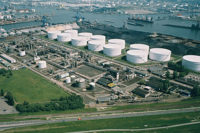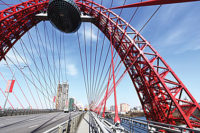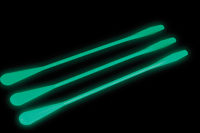
LED displays have a long lifetime, operate extremely efficiently and permit genuinely novel lighting effects. High-performance optical silicones from WACKER allow LEDs to be produced inexpensively and in large quantities.
Light is a symbol of progress. The incandescent light bulb, once the pioneer of a global lighting revolution, is disappearing from store shelves. In tomorrow’s multimedia society, color displays the size of a house will generate crystal-clear images, and entire sports stadiums will be lit by high-performance lamps.
Light can also be used as a tool. For example, laser scalpels have become an indispensable part of medical technology.
These new lighting technologies are driven by energy-efficient light-emitting diodes (LEDs). WACKER’s researchers have developed an innovative UV-curing silicone that makes it relatively inexpensive to manufacture the energy-saving light sources of the future.
The Future of Light
Nothing travels faster than light. Both the Internet and telephones rely on light waves. Fiber-optic cables transmit light pulses around the globe at incredible speeds. The last 10 years, however, have seen both a proliferation of data transfer and new visualization possibilities - cell phones can provide information and books can be read on electronic readers.These technologies are exceptionally efficient thanks to energy-saving LED backlighting. “High energy efficiency, a great color range, stability, long life, brilliance and new design options make light-emitting diodes appealing for all lighting applications,” says Dr. Klaus Angermaier, senior marketing manager, Transportation and Energy, at WACKER. LEDs, he says, are shedding a whole new light on the market.

WACKER's new optical high-performance silicone brand LUMISIL enables optical lenses for LEDs to be produced directly on the light-emitting diode chip. The more-efficient process cuts the traditionally high cost of LED production.
Out with the Old, In with the New
The incandescent lamp has run its course. On Sept. 1, 2009, 100-watt incandescent bulbs were banned from sale in the European Union; lower wattages must be phased out by 2012. According to the Photonik 2020 initiative, about 8 billion incandescent bulbs will eventually need to be replaced worldwide.Various lamp types can be used as replacements, including improved incandescent and halogen lamps, and energy-saving compact fluorescent (CFL) lamps. LED technology is particularly attractive because of its high light yield, which is doubling roughly every three years. A conventional LED can currently provide about 50 lumens per watt; this will likely be increased fourfold soon.
In contrast, an incandescent bulb provides 12 lumens per watt. However, despite being so inefficient, it is still the preferred light source in many households. Incandescent bulbs produce so much heat that fingers can be burned by touching them; only 5% of the energy they consume is actually converted into light.
Switching to more efficient light sources can provide cost and energy savings. Experts estimate that private households in Germany could save up to €2 billion per year.
“The EU expects that, in Germany alone, replacing incandescent with energy-saving lamps will save 7.5 billion kilowatt hours in private households. Replacing these with LEDs will save even more,” says Prof. Norbert Huttenhölscher, director of EnergieAgentur NRW.
“The energy savings for televisions with LED lighting can be as much as 50%,” says Bernd Franke, head of strategy and information at the VDE Institute. “Compared to fluorescent tubes, LEDs save up to 60% energy - and for much longer lifetimes.”
LEDs will take over our roads as well, where updates are needed. “According to estimates by the German Electrical Luminaires and Electrical Lamps Trade Associations,1 for example, 50% of German cities still use street lighting based on 1960s technology,” Hüttenhölscher says.
Climate Protection Technologies, an initiative by the German Federal Environment Ministry, subsidizes the modernization of municipal street lighting. Only 3% of these “vintage” lights are replaced yearly. Nationwide savings are estimated at 2.7 billion kilowatt hours, or €400 million.
The new material blend bonds well and does not cloud the lens, Hüttenhölscher says. Prof. Tran Quoc Khanh of the Lighting Department at Darmstadt Technical University agrees. “The street lamp of the future is the LED lamp. The potential for savings is huge,” Khanh says.
As LED performance increases, the materials used (such as the lenses) must meet new challenges. Materials previously and currently being used can yellow under intense light fluxes. In the future, silicone will be preferred for modern high-performance LEDs. “Silicone elastomers have the necessary heat and light stability,” says Philipp Müller, Ph.D., an applications engineer at WACKER in Burghausen.
With a new optical high-performance silicone, marketed under the trade name LUMISIL®, optical lenses for LEDs are produced directly on the light-emitting diode chip. This efficient method reduces the traditionally high production costs.
“Until now, LED manufacturers had been using a complex injection-molding process to make the silicone lenses. With our product, they can eliminate about five process steps,” Müller says.
The novel silicone is applied by conventional dosing to produce the optical element, which is then flash-cured by exposure to UV light. WACKER’s chemists came up with a material blend that was suitable for this step and also provided optimum adhesion. “The silicone has to bond equally well to both metal and plastic and must not cloud the LED lens,” Müller says.
LEDs Make Driving Safer and Help Reduce Fuel Consumption
The new LED material has found many uses. “One of the world’s leading LED manufacturers endorses LUMISIL, with its outstanding transparency, excellent mechanical strength and long-term resistance to extreme UV exposure,” Müller says. The bright LEDs work well as spots and light-emitting surfaces: energy-saving lamps have lifetimes of about 6,000-15,000 hours; LEDs offer as many as 50,000 hours. Analysts from iSuppli predict that by 2025 one in every three light sources will be an LED.The diodes also protect the climate. Professor Khanh of the Laboratory of Lighting Technology at Darmstadt Technical University says that, with today’s technology alone, Germany could cut its carbon emissions by 1.6 million metric tons per year. This translates to annual savings of €400 million. In global terms, current LEDs could cut the world’s energy demand by around 30% (almost a fifth is still consumed for lighting). Technical advances could slash that by a further 30%, industry experts say, which would save up to 650 million metric tons of CO2.
LEDs are commonly used in automotive applications, offering benefits that include energy and cost savings. The diodes’ low power consumption significantly reduces fuel consumption; in Germany alone, this can save several million liters of fuel per year. The Audi R8 uses LEDs in its main and dipped headlights, position lights, and turn signals.
LED lights offer benefits to drivers as well. At night, the road and curb appear in natural colors, allowing the human eye to better distinguish the contrasts. LED systems also enable intelligent lighting control, in which the intensity is adjusted according to weather and traffic conditions.
The new range of lighting technology that LEDs provide allows novel lighting and illumination solutions to be possible. LEDs allow more flexible control of color shades, giving lighting designers a new range of creative possibilities.
It is only a matter of time until LEDs become an established part of everyday life. Silicones from WACKER will play an important role in this. “With them, we can also serve major markets like the United States and Japan,” says Dr. Bernd Pachaly, head of the Elastomers Business Unit at WACKER. “We are expecting annual growth rates of 20% in LEDs.”
About the Company
WACKER is a global chemical company with some 15,900 employees and annual sales of around €4.3 billion (2008). WACKER has 27 production sites and over 100 sales offices worldwide.For more information, visit www.wacker.com.
1. The German trade associations Electrical Luminaires and Electrical Lamps were replaced by the joint trade association Light in September 2009. For details, visit www.zvei.org.





